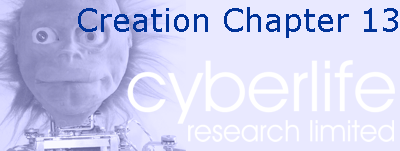
|
|
Three parts gin to one of vermouth1 January 1996: Another year; still no product! But RON II LIVES!!! Finally fixed the major bugs in concept space, decision layer and instinct genes, and Ron & Eve look much healthier again and a lot more alive. Language next... 18 March 1996: Gene switching now works, as does crossing-over. Late-switching genes now overwrite or supplement previous genes according to context. A birth!!!!!!!!!! Installed chemistry for ovulation and pregnancy, and temporary scripts for sex and egg-laying. Ron and Eve gave birth to the first norn bred in captivity! Excerpts from my programming diary for Creatures[1] Compared with building brains, virtual biochemistry is really easy and quite fun. In the space of one chapter we shall give Ron the ability to forget, some pain that he wants to forget, and some pleasures that he will want to remember, such as eating and mating. To keep everything logical and allow you to see why all these chemical processes are related to overall intelligence, we shall start from Ron’s brain and work our way outwards. Forgetting (if I remember it right)<nl>The first of the two things we need to see to before we can tick the box marked ‘design a brain’ is the chemistry for forgetting. As we have seen, the dendrites of concept and action neurones automatically grow towards sources of signal and compete with one another for the right to represent a particular situation or the relationship between a situation and an action. Because Ron is likely to lead a full, rich life, the number of situations he is going to find himself in and the number of actions he will try in response to them are likely to be far greater than the number of neural connections he has available to represent them. Consequently, we need to recycle these connections if they turn out after a while to be unimportant. This is quite easy to do using simulated chemistry. All we need to make is a negative feedback loop that yields a constant supply of loose, uncommitted dendrites – never too many and never too few. [1] These were the good bits – most of the entries relate to endless arguments about the game design, last-minute changes to the specification, and the amount of time wasted on writing demonstrators and reports instead of programming; but such is the nature of software development! |
Copyright © 2004 Cyberlife Research Ltd. |